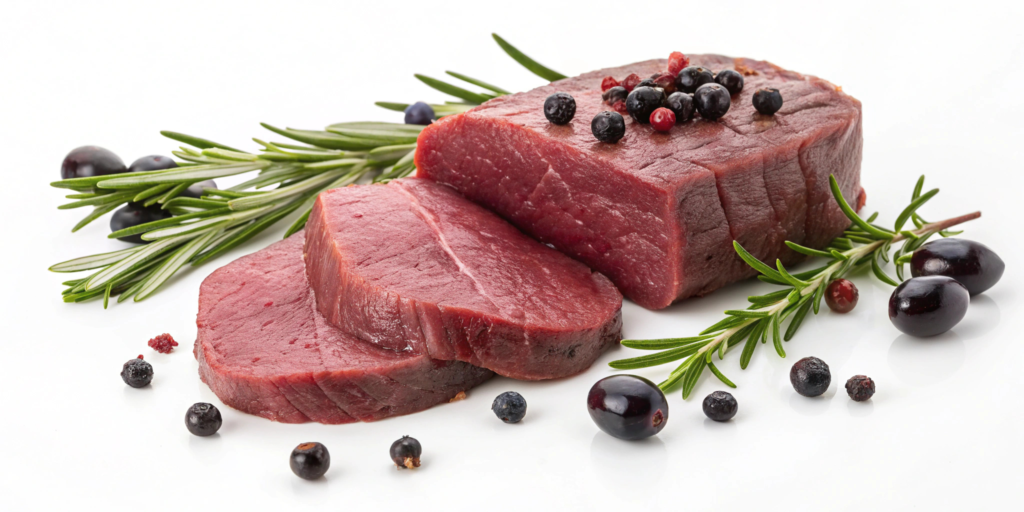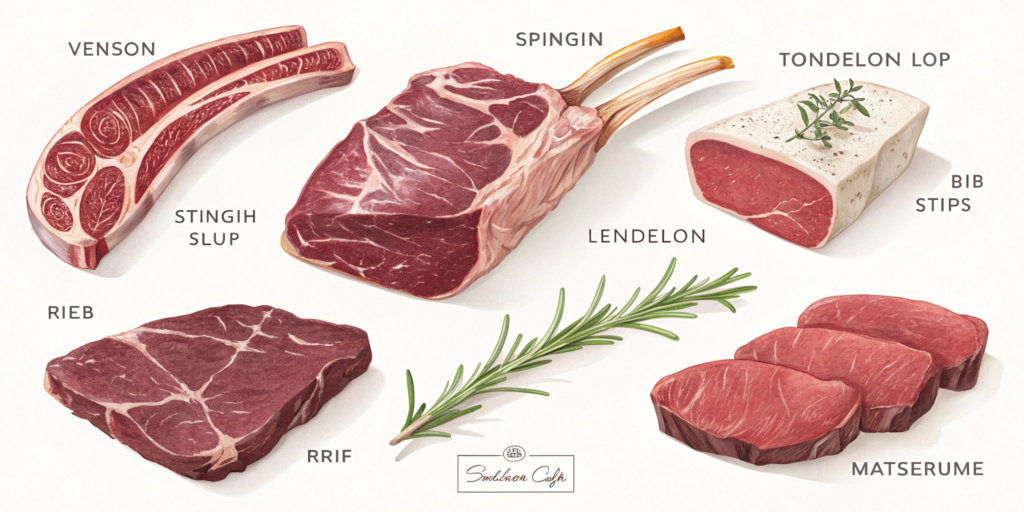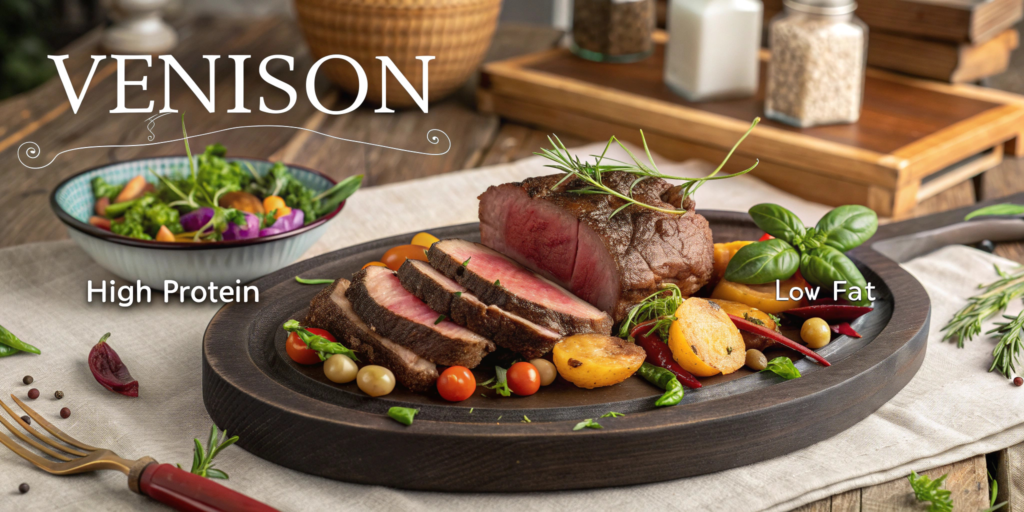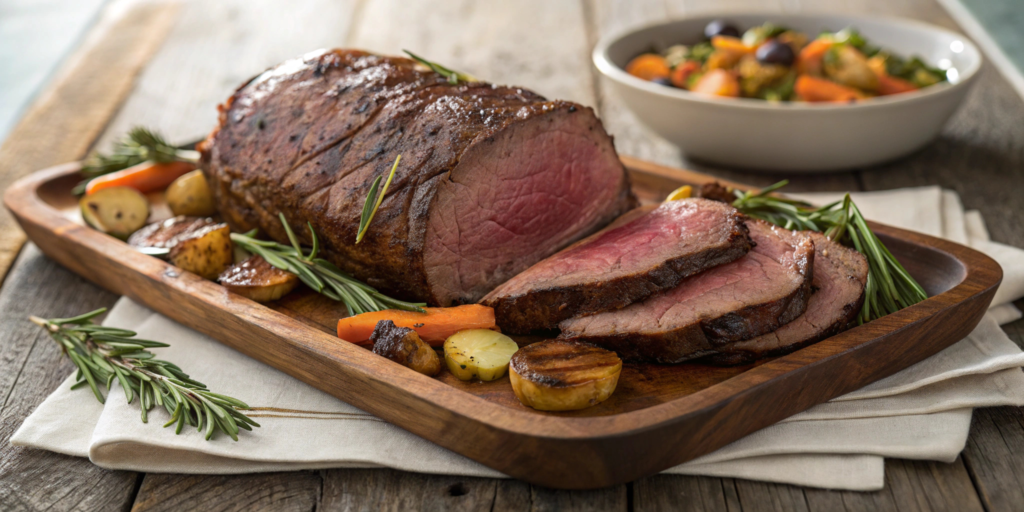
Introduction
Venison, with its rich flavor, stands out. firsly ,While cooking it might seem tricky, the right techniques and simple steps will transform it into a tender masterpiece. This guide offers all the tips to help you cook the perfect Venison Roast Recipe!
Understanding Venison
What is Venison?

Venison refers to the meat derived from deer and is prized for its lean, gamey flavor. Unlike beef or pork, venison stands out due to its uniquely robust flavor and low-fat content. As a result, it offers a healthier alternative to traditional red meats. Its distinct taste stems from the natural diet of deer, which typically includes grasses, berries, and leaves.
Types of Venison Cuts

Understanding the various cuts of venison is key to mastering your venison roast recipe. Each cut offers a unique texture and flavor profile:
- Tenderloin: The most sought-after cut, known for its melt-in-your-mouth tenderness. Perfect for quick cooking methods.
- Shoulder Roast: A flavorful, tougher cut that benefits from slow cooking techniques like braising.
- Leg Roast: Ideal for roasting or slow cooking to achieve tenderness.
- Ground Venison: Best for burgers or meatballs and a versatile option for many recipes.
Nutritional Benefits of Venison

Not only is venison tasty, but it’s also packed with nutrients. This lean protein is low in cholesterol and saturated fats, making it an excellent choice for heart-healthy diets. Venison is rich in essential vitamins and minerals, including iron, zinc, and B vitamins, which boost energy and immunity. For those seeking a nutritious and flavorful alternative to traditional meats, venison is a fantastic option. Discover more about the health benefits of venison : IS VENISON HEALTHY ?
“Venison roast recipes” offer the perfect blend of nutrition and flavor, making them an excellent addition to any cook’s repertoire. By understanding its unique characteristics and nutritional benefits, you’ll be better equipped to make your next venison roast a resounding success.
Preparing the Perfect Venison Roast Recipe
Choosing Quality Meat
The foundation of any great venison roast recipe lies in selecting high-quality meat. Look for cuts that are firm, fine-grained, and deep red. Steer clear of venison with excessive fat or sinew, as these can result in a tough or chewy texture. Cuts like the loin, shoulder, or leg are excellent choices, offering a balance of flavor and tenderness. If possible, source your venison from a reputable supplier or hunter to ensure freshness.
When inspecting venison, remember that less fat is a hallmark of this game meat. However, this means the meat requires careful preparation to avoid dryness during cooking.
Trimming and Aging
Proper preparation begins with trimming the meat. Removing excess fat and the silvery membrane, known as the silver skin, is essential. These parts can impart a bitter or gamey flavor to your roast. Use a sharp knife to carefully slice away these elements, ensuring a clean and flavorful cut.
For the ultimate tenderness, consider aging the venison. Aging allows the natural enzymes in the meat to break down tough fibers, improving texture and taste. Store your venison in a refrigerator set to 34–37°F (1–3°C) for up to two weeks. This step is especially helpful for larger cuts like the shoulder or leg roast. Explore more techniques to make venison tender.
Marinating and Seasoning
To enhance the flavor of your venison roast recipe, marinating is a must. Marinades not only add depth to the meat’s natural flavor but also help tenderize it. Here are a few classic marinades to consider:
- Red wine, garlic, and rosemary: A timeless combination that complements venison’s rich taste.
- Soy sauce, brown sugar, and sesame oil: Adds a savory-sweet profile with a hint of umami.
- Balsamic vinegar, Dijon mustard, and shallots: Perfect for a tangy, sophisticated flavor.
Dry rubs are another excellent option for seasoning your roast. Create a spice blend using ingredients like smoked paprika, garlic powder, and black pepper to form a delicious crust. For those who prefer extra moisture, try brining your venison in a saltwater solution to ensure a juicy result.
Cooking Techniques for Venison Roast Recipe
Slow Roasting Method

When it comes to making a venison roast recipe that melts in your mouth, slow roasting is hard to beat. This method involves cooking at a low temperature over several hours, which allows the connective tissues in the meat to break down gently. Preheat your oven to 275°F (135°C) and place your seasoned venison on a roasting rack inside a pan.
Add a small amount of liquid—such as broth, wine, or water—to the pan to create steam, which keeps the roast moist. Cover the pan tightly with foil and roast for 2–3 hours, depending on the size of the cut. Be sure to baste the meat every 30 minutes to lock in flavor and moisture. Slow roasting is perfect for shoulder and leg cuts.
High-Heat Searing Method
If you prefer a crisp, caramelized exterior, the high-heat searing method is ideal. Start by preheating a skillet until it’s piping hot, then sear your venison roast on all sides for 1–2 minutes per side. This step locks in the meat’s natural juices and creates a flavorful crust.
After searing, transfer the venison to an oven preheated to 400°F (205°C). Roast the meat until it reaches your desired level of doneness—about 135°F (57°C) for medium-rare or 145°F (63°C) for medium. This method works exceptionally well for tender cuts like the loin.
Temperature and Timing
Achieving the right temperature and timing is crucial for a perfect venison roast recipe. Use a meat thermometer to monitor the internal temperature:
- Medium-rare: 130–135°F (54–57°C)
- Medium: 140–145°F (60–63°C)
Cooking times vary depending on the cut and size. For instance, a tenderloin roast may only take 20–30 minutes, while larger cuts like the shoulder could require up to 2 hours.
By mastering these cooking techniques, you’ll produce a venison roast that’s tender, juicy, and bursting with flavor. With these tips, you’re ready to elevate your next dinner to gourmet levels!
Complementary Side Dishes for Venison Roast Recipe
Hearty Vegetable Pairings
A well-prepared venison roast recipe deserves equally delightful sides. Roasted root vegetables like carrots, parsnips, and potatoes are classic choices that balance venison’s bold, earthy flavors. The natural sweetness of these veggies pairs beautifully with the robust taste of game meat. Toss them in olive oil, sprinkle with fresh thyme, and roast until caramelized for a simple yet flavorful accompaniment.
For a touch of richness, try braised red cabbage. Its tangy-sweet profile complements venison and adds a vibrant pop of color to your plate.
Grain and Salad Options
Grain-based dishes like wild rice pilaf or farro salads provide a hearty and nutritious pairing. For a seasonal twist, mix the grains with cranberries, walnuts, and a citrus vinaigrette to add depth and texture.
If you’re looking for something fresh, opt for a crisp salad featuring mixed greens, dried fruits, and a tangy dressing. A drizzle of balsamic reduction or a hint of goat cheese can elevate this side to gourmet status.
Bread and Spreads
Don’t overlook bread as a simple yet effective pairing. Warm, crusty rolls or slices of rustic bread are perfect for soaking up the venison’s juices or accompanying a rich gravy. Consider serving with a side of cranberry compote or horseradish cream for added flair.
For more recipes that pair perfectly with game meat, check out How to Cook Venison.
Troubleshooting Common Issues for Venison Roast Recipe
Avoiding Dryness
One of the most common challenges with a venison roast recipe is dryness due to the meat’s low fat content. To keep it moist, consider brining the venison in a saltwater solution before cooking. Basting the roast regularly with its own juices or a flavorful marinade during cooking also helps retain moisture. Slow roasting at low temperatures ensures even cooking and prevents drying out.
Minimizing Gamey Flavor
Venison’s gamey flavor, while beloved by many, may be too intense for some. To reduce this, soak the meat in buttermilk, vinegar, or a wine-based marinade for several hours. The acids help mellow the strong taste. Additionally, seasoning the roast with aromatic herbs like rosemary, thyme, and garlic can balance the boldness. Learn how to adjust venison’s flavor to suit different palates.
Perfecting Temperature Control
Temperature precision is key to a tender, juicy venison roast. Use a reliable meat thermometer to ensure the internal temperature reaches 130–135°F for medium-rare or 140–145°F for medium. Searing the meat before roasting creates a flavorful crust and locks in moisture.
By following these troubleshooting tips, even first-time cooks can master the art of a perfect venison roast recipe. Experiment with these techniques to overcome common challenges and enjoy a dish that’s as satisfying as it is delicious.
Serving and Presentation
Resting and Carving Tips
After preparing a mouthwatering venison roast recipe, don’t rush to serve it right away. Let the roast rest for at least 10–15 minutes after removing it from the heat. This crucial step allows the juices to redistribute, ensuring every bite is moist and tender.
When it’s time to carve, use a sharp knife and cut the roast against the grain. This technique shortens the muscle fibers, making the meat more tender. Slice into even portions, and arrange them neatly on a platter for an elegant presentation.
Wine Pairing Suggestions
The right wine can elevate your venison roast recipe to a gourmet level. Full-bodied red wines like Cabernet Sauvignon or Syrah complement the deep, earthy flavors of venison beautifully. For those who prefer a lighter option, Pinot Noir offers a delicate balance that doesn’t overpower the dish.
If you’re feeling adventurous, pair your roast with a dry Riesling or Gewürztraminer for a refreshing contrast. Serve the wine slightly chilled to enhance its flavors and bring a touch of sophistication to your meal.
FAQs Section
How do you cook venison so it’s tender?
Tender venison starts with slow cooking or braising at low temperatures. Techniques like brining or marinating before cooking help break down tough fibers, while resting the meat after roasting ensures it stays juicy.
What is the best way to roast venison?
The best way to prepare a venison roast recipe is by searing the meat first to lock in moisture, then slow-roasting it in the oven at a steady temperature. Basting it with its juices or a marinade enhances flavor and prevents drying out.
How long do you cook a venison roast for?
Cooking time depends on the size and cut of the meat. A general rule is 20–25 minutes per pound at 325°F for medium doneness. Always use a meat thermometer to check that the internal temperature meets your preference.
How do you cook venison so it’s not gamey?
Reducing gamey flavor is all about preparation. Soaking the venison in buttermilk, wine, or vinegar for several hours can tame its strong taste. Adding bold spices and aromatic herbs during cooking also helps balance the flavor.
What are some good side dishes to serve with a venison roast?
Classic sides like roasted root vegetables, creamy mashed potatoes, or wild rice pilaf pair wonderfully with venison. For a lighter option, a crisp salad with citrus vinaigrette or crusty bread can round out the meal perfectly.
With these FAQs, even beginners can confidently prepare a memorable venison roast recipe. Whether you’re impressing guests or enjoying a cozy dinner, these tips and tricks will make your dish unforgettable.
Conclusion
Wrapping It Up
Mastering a venison roast recipe is about more than just following instructions—it’s about embracing the unique qualities of this game meat. From selecting the right cut to using marinades and cooking techniques, every step matters in achieving a tender, flavorful roast. Don’t forget to pair it with complementary side dishes and wine to complete the dining experience.
Experiment, have fun, and enjoy the process of creating a meal that’s as rewarding to cook as it is to eat. Whether you’re a seasoned hunter or a curious home cook, venison is a versatile and delicious choice that’s worth celebrating.
